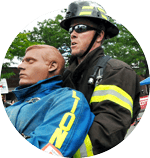- November 08, 2016
- By Charlie Wright
It was supposed to be just another training day for fire departments from the D.C. region, but when the first firefighter in all his gear threw the coiled hose over his shoulder and sprinted up the tower, the crowd erupted in cheers. It didn’t stop for three hours.

Paul Davis Ph.D. ‘76, who organized this 1991 event at the Maryland Fire and Rescue Institute on campus to gauge new recruits’ physical fitness, was stunned. “There’s something here. We have to capture this,” he recalls thinking. “It was not hard to segue over into creating a sport out of what was essentially an applied research study.”
Today, the Scott Firefighter Combat Challenge is the premier measure of firefighter fitness, used by departments around the world. The 2016 world competition, held in Montgomery, Alabama, Oct. 24–29, drew 500 firefighters from 12 countries, including Kuwait, New Zealand and Poland, and was live-streamed on the Firefighter Challenge website and ESPN 3. Over 1,000 races were run throughout the week, including individual and team events grouped by age and gender.
The contest has all the drama of the Olympics, except these competitors are wearing their firefighting uniforms, including a heavy helmet, boots and compressed air tank. Firefighters must climb a five-story tower carrying a 42-pound shoulder load. At the top of the winding metal staircase, they must yank a rope with another 42-pound load attached, flip it over a short wall, and sprint down the tower, making sure to touch every step.
Next is the Keiser forcible entry simulator, straddling a 160-pound steel beam and driving it a distance of five feet with a sledgehammer. Participants then weave through pylons like football players avoiding tackles, grab a hose and burst through saloon doors to douse a target.

Finally, the firefighters scoop up a 175-pound mannequin by its rubbery armpits and drag the lifeless replica across the finish line. The distances and weights are calculated to simulate the constraints of an actual fire and rescue mission, and times are recorded by a sensor in the dummy’s feet.
Davis, an expert on occupational fitness requirements and former firefighter, was a defense contractor when he started the challenge, working with the FBI and Secret Service to increase physical fitness in the workplace. He also served as an expert witness in over 60 legal proceedings, putting to use his vast knowledge of fitness standards and equal opportunity employment. During his time promoting physical fitness in a professional setting, Davis realized that firefighters, like workers in many fields, were lacking in this area.
“We needed some kind of competition that would raise awareness for the need for fitness,” Davis says. “Unlike push-ups and sit-ups and running a mile and a half,” firefighters would benefit more from exercises that reflected the demands of safely performing at the scene of a fire.
Prince George’s County Deputy Fire Chief Ben Barksdale, who participated for more than two decades, says it requires firefighters to be in tip-top shape, to have both endurance and muscular strength.
“For years, guys would complain about the annual physical fitness test,” says Barksdale. “The excuse was that ‘Well, I never have to do this on the fire ground.’ Then Dr. Davis comes along with this to use as a physical fitness assessment and … those who participate definitely see a benefit.”
